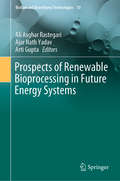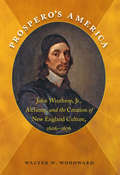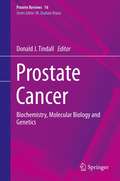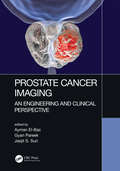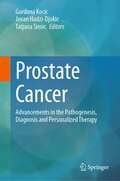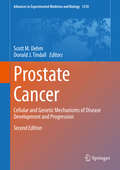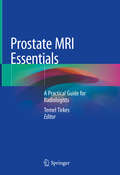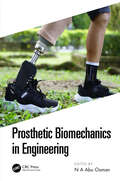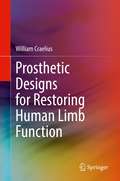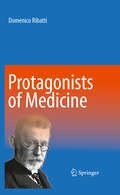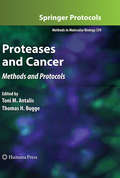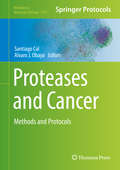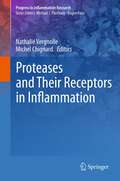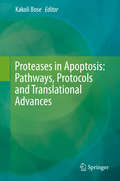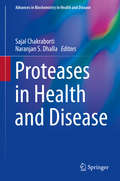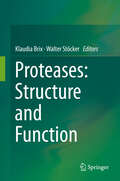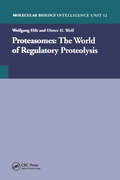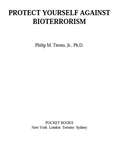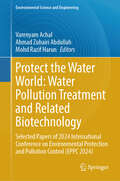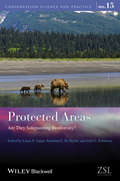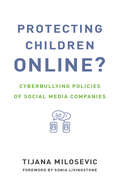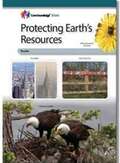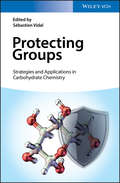- Table View
- List View
Prospects of Renewable Bioprocessing in Future Energy Systems (Biofuel and Biorefinery Technologies #10)
by Ajar Nath Yadav Arti Gupta Ali Asghar RastegariThis book discusses various renewable energy resources and technologies. Topics covered include recent advances in photobioreactor design; microalgal biomass harvesting, drying, and processing; and technological advances and optimised production systems as prerequisites for achieving a positive energy balance. It highlights alternative resources that can be used to replace fossil fuels, such as algal biofuels, biodiesel, bioethanol, and biohydrogen. Further, it reviews microbial technologies, discusses an immobilization method, and highlights the efficiency of enzymes as a key factor in biofuel production. In closing, the book outlines future research directions to increase oil yields in microalgae, which could create new opportunities for lipid-based biofuels, and provides an outlook on the future of global biofuel production. Given its scope, the book will appeal to all researchers and engineers working in the renewable energy sector.
Prospero's America
by Walter W. WoodwardIn Prospero's America, Walter W. Woodward examines the transfer of alchemical culture to America by John Winthrop, Jr., one of English colonization's early giants. Winthrop participated in a pan-European network of natural philosophers who believed alchemy could improve the human condition and hasten Christ's Second Coming. Woodward demonstrates the influence of Winthrop and his philosophy on New England's cultural formation: its settlement, economy, religious toleration, Indian relations, medical practice, witchcraft prosecution, and imperial diplomacy. Prospero's America reconceptualizes the significance of early modern science in shaping New England hand in hand with Puritanism and politics.
Prostate Cancer
by Donald J. TindallProstate Cancer provides an up to date review of the biochemistry, molecular biology, and genetic changes in prostate cells that are the driving forces in the initiation and progression of cancer. It includes an overview by experts in the field of cell-cell interactions, including stem cells, reactive Stromal cells and membrane lipid rafts that are instrumental in the initiation and progression of prostate cancer.
Prostate Cancer Imaging: An Engineering and Clinical Perspective
by Jasjit Suri Ayman El-Baz Gyan PareekThis book covers novel strategies and state of the art approaches for automated non-invasive systems for early prostate cancer diagnosis. Prostate cancer is the most frequently diagnosed malignancy after skin cancer and the second leading cause of cancer related male deaths in the USA after lung cancer. However, early detection of prostate cancer increases chances of patients’ survival. Generally, The CAD systems analyze the prostate images in three steps: (i) prostate segmentation; (ii) Prostate description or feature extraction; and (iii) classification of the prostate status. Explores all of the latest research and developments in state-of-the art imaging of the prostate from world class experts. Contains a comprehensive overview of 2D/3D Shape Modeling for MRI data. Presents a detailed examination of automated segmentation of the prostate in 3D imaging. Examines Computer-Aided-Diagnosis through automated techniques. There will be extensive references at the end of each chapter to enhance further study.
Prostate Cancer: Advancements in the Pathogenesis, Diagnosis and Personalized Therapy
by Gordana Kocic Jovan Hadzi-Djokic Tatjana SimicThis book provides an in-depth exploration of the biology of prostate cancer, from its cellular origins to its clinical manifestations and therapeutic options. In addition to thoroughly covering a variety of diagnostic methods, radical procedures, radiation therapy, hormone therapy, and surgical techniques for prostatectomy, the book seeks to improve the understanding of the development of prostate cancer. Delving into the latest research and scientific advancements, the book starts by shedding light on the critical role of genetic susceptibility, redox signaling, apoptosis, epigenomics, transcriptomics, and metabolic reprogramming in prostate cancer development and progression. In the following section key concepts in prostate cancer diagnostics are covered. This includes the diagnostic, prognostic, and theranostic potential of miRNAs in prostate cancer; the necessity of biopsy; and the importance of histopathological and molecular markers in assessing aggressivity. It alsoexplores recent advances in tumor markers for early detection and monitoring, as well as biological markers of therapeutic response. The book concludes by offering a wealth of knowledge on current treatment options for prostate cancer, including surgical treatments, hormone therapy for advanced cases, the use of apheresis in personalized cell-mediated treatment, pharmacogenomics and precision therapy challenges and perspectives, stereotactic radiotherapy, and treatment for castration-resistant prostate cancer. Scientists and medical professionals interested in basic and clinical research in urology and oncology will find this book to be a useful reference. It is a helpful tool for preparing medical specialization in pathology, oncology, urology, clinical biochemistry, laboratory medicine, diagnostic radiology, oncologic radiology, and related fields of cancer research. With its integrative approach to diagnostics and focus on recent scientific breakthroughs, this book empowers readers to deepen their understanding of prostate cancer and enhance their ability to advance basic and clinical research to treat this pervasive disease.
Prostate Cancer: Cellular and Genetic Mechanisms of Disease Development and Progression (Advances in Experimental Medicine and Biology #1210)
by Donald J. Tindall Scott M. DehmThe purpose of this book is to provide a contemporary overview of the causes and consequences of prostate cancer from a cellular and genetic perspective. Written by experts in the fields of epidemiology, toxicology, cell biology, genetics, genomics, cell-cell interactions, cell signaling, hormone signaling, and transcriptional regulation, the text covers aspects of prostate cancer from disease initiation to metastasis.Chapters explore in depth the cells of origin for prostate cancer, its genomic subtypes, neural transcription factors in disease progression, epigenetic regulation of chromatin, and many other topics. This book distinguishes itself from other texts on prostate cancer by its focus on cellular and genetic mechanisms, as opposed to clinical diagnosis and management. As a result, this book will be of broad interest to basic and translational scientists with familiarity of these topics, as well as to trainees at earlier stages of their research careers.
Prostate MRI Essentials: A Practical Guide for Radiologists
by Temel TirkesThis book is a basic, practical guide to performing and interpreting state-of-the-art prostate MRI, utilizing the latest guidelines in the field. Prostate MRI has become one of the fastest growing examinations in the radiology practice, and this demand has continuously increased within the past decade. Since it is relatively new, MRI of the prostate is predominantly being performed at academic institutions, however there is a growing demand within the lower-tier health care institutions to offer this examination to their patients. This is an ideal guide for radiologists who want to enhance or initiate prostate MRI service for their referring clinicians and as a manual for technologists and those who are in training. Prostate cancer is the second leading cause of cancer death in men, exceeded only by lung cancer. The best predictor of disease outcome lies with correct diagnosis, which requires precise imaging and diagnostic procedures aided by prostate MRI. Urologists, medical oncologists and radiation oncologists all agree that multi-parametric prostate MRI is essential for evaluation of prostate cancer. However, the technical aspects of prostate MR imaging are not as straightforward as for the other imaging modalities and constantly evolving. Its small size presents a real challenge to the radiologist, who needs to do the T2 and diffusion weighted images and perform a dynamic contrast enhanced sequence correctly. These images may also need to be analyzed on an independent workstation. Due to the absence of a current reference manual, when a radiologist wants to establish a prostate imaging service, he/she needs to attend dedicated prostate MR workshops or dive into the literature search alone, only to get more confused about what to do and how to do it. With this book, expert authors were asked to give clear guidance to those who want to enhance or initiate their prostate imaging service. With this much-needed, concise, practical guidance, radiologists can perform and interpret multi-parametric prostate MRI in a standardized fashion, in concordance with PI-RADS v2.1 that can be applicable to all available hardware platforms (GE, Philips, Siemens, Toshiba). Additionally, they can perform post-processing for possible targeted biopsy and interpret post-therapy and PET studies. The book discusses imaging protocols (planning and prescription) and sequence parameters with representative images for each MRI sequence. This handbook-style practical manual can be used in the radiology reading room by those interpreting the MR exam as a reference as well as at the MRI scanner by the technologists as a guide. Coverage of basic prostate anatomy, pathology, Urologists’ point of view, MRI guided radiation treatment planning and molecular imaging is also included. Throughout the book, authors will discuss basics, pitfalls, and provide tips in image acquisition and interpretation, alongside several case examples.
Prosthetic Biomechanics in Engineering
by Osman AbuProsthetic biomechanics is an interdisciplinary field of engineering, medicine, and biology, focused on enhancing people’s lifestyles. In the past 20 years, the field of prosthetic biomechanics and its potential have grown due to the support of advances in engineering technologies. Prosthetic Biomechanics in Engineering is about the recent advances in prosthetic engineering research. The scope of the book is focused on the design, development, and evaluation of a prosthetic systems that are being used in biomechanical applications. The book covers advanced materials, conceptual design, classification, ergonomics design applications, brain computer interface (BCI) system, motion analysis, postural stand stability, upper and lower limb prosthetics, types of suspension systems for prosthetics, Fiber Bragg Grating-based techniques, and pressure on the residual limb and the socket. The early chapters effectively describe new sensors for in-socket systems, new pylon material, and advanced gait analysis. Further chapters discuss advanced techniques for the design and development of prosthetics based on clinical and emergency uses. The information provided in this book is intended for researchers and investigators to encourage further advances in the field of prosthetics research, and for the development of rehabilitation equipment for the improvement of human health, and it: Presents recent advances in prosthetic biomechanics engineering research Discusses the design and development of limb prosthetic systems Explores advanced concepts of the prosthetic sockets Describes gait analysis of prosthetics and orthotics Dr Noor Azuan Abu Osman is a practicing engineer and Professor of Biomechanics with Department of Biomedical Engineering, Faculty of Engineering, University of Malaya, Malaysia.
Prosthetic Designs for Restoring Human Limb Function
by William CraeliusThis textbook provides a thorough introduction and overview of the design and engineering of state-of-the-art prosthetics and assistive technologies. Innovations in prosthetics are increasingly made by cross-disciplinary thinking, and the author introduces the application of biomedical, mechanical, electrical, computer, and materials engineering principles to the design of artificial limbs. Coverage includes the fundamentals of biomechanics, biomechanical modeling and measurements, the basics of anatomy and physiology of limb defects, and the historical development of prosthetic design. This book stimulates the innovative thinking necessary for advancing limb restoration, and will be essential reading for students, as well as researchers, professional engineers, and prosthetists involved in the design and manufacture of artificial limbs.Learning enhanced by the exercises, including physical modeling with MATLAB and Simulink;Includes appendices with relevant equations and parameters for reference;Introduction to the design and engineering of prosthetics and assistive technologies.
Prosthetic Immortalities: Biology, Transhumanism, and the Search for Indefinite Life (Posthumanities #71)
by Adam R RosenthalExamining the links between today&’s ideas of radical life extension and age-old notions of immortality From Plato&’s notion of generation to Derrida&’s concept of survival to such modern phenomena as anti-aging treatments, cryogenics, cloning, and whole-brain uploads, Adam Rosenthal&’s Prosthetic Immortalities shows how the dream of indefinite life has always been a technological one: a matter of prosthesis. He argues that every biological instance of perpetual life, from one-celled organisms to rejuvenating jellyfish to Henrietta Lacks&’s &“immortal&” cancer cells, always results in the transformation of the original being. There can, therefore, be no certainty of immortality. Yet, because finite mortal life is already marked by difference, division, and change, as Rosenthal concludes: &“the problem of immortality will not cease to haunt us.&” Prosthetic Immortalities examines the persistence of humans&’ aspirations of deathlessness, showing that the link between immortalization and prostheticization is not unique to a single period but is, rather, a ubiquitous element of the discourse of immortality, encompassing both modern technoscientific efforts and religious discourses of an afterlife. Rosenthal asks to what extent the emergence of a virtual, posited, immortal presence follows from the tenets of empirical science—and not simply from the discourse of biology but also, and more radically still, from biological organization itself. Rosenthal ultimately argues that the discovery of biological immortals—lifeforms that naturally have indefinitely long lifespans, such as cancer cells and bacteria—present novel conceptual difficulties for traditional philosophical approaches to mortality and selfhood, asking whether it is life itself that first births immortalizing prostheses.
Protagonists of Medicine
by Domenico RibattiThe study of medical history is interesting in itself and may help to modify the view sometimes expressed that medical students and doctors are lacking in culture of any sort. Moreover, some historical perspective is often advantageous when one is considering the multitude of advances that are now taking place in the theory and practice of medicine. This book, containing a series of collected papers concerning immunology and pathology and vascular biology and angiogenesis, drives us through scientific milestones in the history of medicine in the course of the past two centuries and highlights the contribution of pioneering scientists whose discoveries have paved the way to many researchers working in the fields of cell biology, developmental biology, immunology, pathology, and oncology. This book will serve as a resource for scientists, historians of medicine and philosophers of science and medicine.
Proteases and Cancer
by Thomas H. Bugge Toni M. AntalisProteases decisively contribute to cancer development and promotion by regulating the activities of growth factors/cytokines and signaling receptors, as well as the composition of the extracellular matrix, thereby suppressing cell death pathways and activating cell survival pathways. In Proteases and Cancer: Methods and Protocols, expert researchers bring together a wide range of current, complimentary techniques that have been developed for the specific detection and analysis of proteases and their activities in cancer biology. The volume covers vital topics including the application of proteomics technologies for the detection of protease expression in tumors, imaging proteases by activity profiling, proteomics technologies for the identification of biological substrates, detection of cell surface proteolysis, imaging of protease activity, the use of transgenic mice to determine protease function in tumor initiation and progression, and the development of anti-protease therapies for cancer. Written in the highly successful Methods in Molecular BiologyTM series format, chapters include introductions to their respective topics, lists of the necessary materials and reagents, step-by-step, readily reproducible laboratory protocols, and notes on troubleshooting and avoiding known pitfalls. Authoritative and easy to use, Proteases and Cancer: Methods and Protocols is an ideal guide for scientists who wish to pursue the study of this important branch of cancer research and the development of unique innovative technologies to aid in that study.
Proteases and Cancer: Methods And Protocols (Methods In Molecular Biology #1731)
by Santiago Cal Alvaro J. ObayaThis volume explores the role of proteases in various catalytic classes and cellular processes associated with cancer. The chapters in this book cover topics such as encoding proteolytic enzymes, cleavage sites of proteases, functional catalytic domains of MMPs, zymography, angiogenesis and lymphangiogenesis, genetic and epigenetic alterations of metallopeptidases, and methods to target metalloproteinases. Written in the highly successful Methods in Molecular Biology series format, chapters include introductions to their respective topics, lists of the necessary materials and reagents, step-by-step, readily reproducible laboratory protocols, and tips on troubleshooting and avoiding known pitfalls. Comprehensive and cutting edge, Proteases and Cancer: Methods and Protocols is a valuable resource for clinical researchers across numerous fields such as molecular and cellular biology, oncology, biochemistry, and chemistry. This book is also useful for PhD students in the various disciples of health sciences.
Proteases and Their Receptors in Inflammation
by Michel Chignard Nathalie VergnolleProteases are everywhere from prokaryotes to eukaryotes, from virus to bacteria and in all human tissues, playing a role in many biological functions. Among these functions, the inflammatory reaction is of particular interest. In inflamed tissues, proteases can have a microbial and/or host origin and are involved not only in tissue remodeling, but also in specific signaling to resident or inflammatory cells, thereby contributing to the innate immune response. This volume presents all advances in our knowledge of the role proteases and their inhibitors play in various diseases associated with inflammatory response. Mechanisms involved in protease signaling to cells are presented, and the different types of proteases that are present at inflammatory sites and their effects on the course of inflammation are discussed. Finally, the evidence for considering proteases and their receptors as potential molecular targets for therapeutic interventions in the treatment of inflammatory diseases is discussed in the context of specific organ inflammatory pathologies (the lung, gastrointestinal tract, skin, joints, etc.).
Proteases in Apoptosis: Pathways, Protocols and Translational Advances
by Kakoli BoseThis book provides a comprehensive overview of the proteases involved in programmed cell death. It presents a focused yet extensive discussion on proteolytic enzymes such as caspases, HtrAs, granzymes, calpains and cathepsins as well as laboratory protocols related to enzymology and apoptosis. Mouse model systems and non-invasive imaging techniques in apoptosis-related diseases such as cancer and neurodegeneration are also covered in this book. While slowly unravelling the complexities of apoptosis in chapter one, the next three chapters individually elaborate on different classes of proteases that play key roles in the initiation, progression and execution of programmed cell death. The last two chapters complete this discussion by describing different laboratory methodologies and therapeutic advances involving apoptotic proteases. Protocols portraying in vitro and ex vivo colorimetric and fluorescence-based enzyme kinetic studies as well as cell death assays are explained in the fifth chapter. Preclinical in vivo models and non-invasive imaging in apoptosis to understand the complexities of disease progression and their contribution toward therapeutics is recounted in the last chapter. The book spans topics related to both fundamental and applied biology. It would therefore be equally appealing and informative to scientists working in the field of apoptosis and those who are investigating mechanisms of proteases and enzymes in general. The protocols would certainly benefit both graduate and undergraduate students working in the related fields and provide useful leads for drug design to translational biologists involved in neurodegeneration and cancer research.
Proteases in Health and Disease
by Naranjan S. Dhalla Sajal ChakrabortiIn view of rapidly growing research in the deregulation of proteases and their impact in human health and diseases, this book will highlight existing and emerging research in this exciting area. In-depth critical state-of-the-art reviews will be written by established investigators on proteases dysfunctions associated with pathogenesis of different diseases that are known to occur due to deregulation of proteolytic systems. Multidisciplinary approaches demonstrating biochemical and signal transduction mechanisms associated with deregulation of proteases leading to manifestation of the diseases will be discussed. The book highlights the roles of both intracellular and extracellular proteases in health and disease.
Proteases: Structure and Function
by Klaudia Brix Walter StöckerProteolysis is an irreversible posttranslational modification affecting each and every protein from its biosynthesis to its degradation. Limited proteolysis regulates targeting and activity throughout the lifetime of proteins. Balancing proteolysis is therefore crucial for physiological homeostasis. Control mechanisms include proteolytic maturation of zymogens resulting in active proteases and the shut down of proteolysis by counteracting endogenous protease inhibitors. Beyond the protein level, proteolytic enzymes are involved in key decisions during development that determine life and death - from single cells to adult individuals. In particular, we are becoming aware of the subtle role that proteases play in signaling events within proteolysis networks, in which the enzymes act synergistically and form alliances in a web-like fashion. Proteases come in different flavors. At least five families of mechanistically distinct enzymes and even more inhibitor families are known to date, many family members are still to be studied in detail. We have learned a lot about the diversity of the about 600 proteases in the human genome and begin to understand their physiological roles in the degradome. However, there are still many open questions regarding their actions in pathophysiology. It is in this area where the development of small molecule inhibitors as therapeutic agents is extremely promising. Approaching proteolysis as the most important, irreversible post-translational protein modification essentially requires an integrated effort of complementary research disciplines. In fact, proteolytic enzymes seem as diverse as the scientists working with these intriguing proteins. This book reflects the efforts of many in this exciting field of research where team and network formations are essential to move ahead.
Proteasomes: The World of Regulatory Proteolysis
by Wolfgang Hilt Dieter H. WolfThis book highlights proteasome structures and how they are related to different aspects of proteasome function. Moreover, the book reports on the functional roles these highly developed proteolytic machines play within the cell. It was a great surprise to the scientific world that proteolysis provides crucial functions in cellular regulation. The
Protect Your Pet: More Shocking Facts
by Ann M. MartinFrom the Book jacket: ANN N. MARTIN is internationally recognized as an authority on the commercial pet food controversy. Her book, Food Pets Die For: Shocking Facts About Pet Food, was the first book to expose the hazards of commercial pet food. In Protect Your Pet Ms. Martin continues her thorough and revealing investigation of commercial pet foods as well as other pet-related issues, including the dangers of over-vaccination, the increased cancer rate in companion animals, the raw-meat diet debate, and more.
Protect Yourself Against Bioterrorism
by Philip M. Tierno Jr.How does anthrax spread? Should I avoid opening my mail? Wasn't I vaccinated for smallpox years ago? What exactly is encephalitis? Is my workplace a target for bioterrorism? What precautions can I take to stay healthy and safe? PROTECT YOURSELF AGAINST BIOTERRORISM. From fears of full-scale germ warfare to the spread of dangerous and deadly illnesses, we are faced with a new breed of anxiety -- and more questions than ever -- about our safety and well-being in the face of bioterrorism. Dr. Philip M. Tierno, a member of the New York City Mayor's Task Force on Bioterrorism, addresses our fears with the most powerful antidote: information. Dr. Tierno explains: how germs can be used as potential weapons and how they can't, how to distinguish the symptoms of a deadly disease from a run-of-the-mill bug, how these diseases are treated, how to assess the level of risk we face in our daily lives, how to sort fact from myth in the face of frightening new developments, what you can do to safeguard your family's health, and more.
Protect the Water World: Selected Papers of 2024 International Conference on Environmental Protection and Pollution Control (EPPC 2024) (Environmental Science and Engineering)
by Varenyam Achal Ahmad Zuhairi Abdullah Mohd Razif HarunThis book unveils the advancements in water pollution analysis and its biological treatment technology and provides valuable research and experience for engineers and scholars. On March 22, 2024, in the United Nations World Water Development Report, the theme of this year's conference, "Water for Promoting Prosperity and Peace," aligns with Global Water Partnerships' long-standing mission and vision of integrated water resources management. Currently, around half of the world's population faces severe water scarcity for at least part of the year, and a quarter of the global population experiences "extremely high" water stress. Meanwhile, global freshwater usage is growing at a rate slightly below 1% annually. Hence, the protection of water resources and pollution control, particularly the renewal and management of freshwater resources, deserve significant attention. Emerging pollutants of concern include per- and polyfluoroalkyl substances (PFAS), pharmaceuticals, hormones, industrial chemicals, detergents, cyanotoxins, and nanomaterials. High concentrations of antimicrobial agents have been found worldwide, originating from inadequately treated household wastewater, livestock, and aquaculture. Biological treatment technology for water pollution uses microorganisms to break down pollutants into harmless or less toxic substances, becoming an important means of addressing water pollution. Its advantages lie in low cost, adaptability, and the ability to effectively treat various organic pollutants, including hydrocarbons, pharmaceuticals, and pesticides. However, the effectiveness of this technology depends on the selection of appropriate microbial strains and the optimization of treatment conditions (such as temperature, pH, and nutrients). In the aspect of water pollution analysis, accurate detection of the types and concentrations of pollutants is a prerequisite for management and remediation. Modern instruments, such as gas chromatography-mass spectrometry (GC-MS) and liquid chromatography-mass spectrometry (LC-MS), can identify and quantify trace pollutants in complex water bodies. Additionally, new-generation sensing technologies and biological detection tools, like DNA microarrays and gene sequencing technologies, enable rapid detection of specific pollutants and reveal microbial community responses to pollutants. These technologies can effectively target and treat heavy industrial and chemical pollution, thereby protecting water environmental safety. This book aims to facilitate the exchange of scientific information among scholars from leading universities, research centers, and high-tech enterprises around the world. This book is highly beneficial to scholars, engineers, and researchers in the fields of environmental engineering and water pollution.
Protected Areas
by John G. Robinson Jonathan E. Bailie Lucas N. JoppaProtected areas spearhead our response to the rapidly accelerating biodiversity crisis. However, while the number of protected areas has been growing rapidly over the past 20 years, the extent to which the world's protected areas are effectively conserving species, ecosystems, and ecosystem services is poorly understood. Highlights new techniques for better management and monitoring of protected areas Sets guidelines for the decision making processes involved in setting up and maintaining protected areas Fully international in scope and covering all ecosystems and biomes
Protecting Children Online?: Cyberbullying Policies of Social Media Companies (The Information Society Series)
by Tijana MilosevicA critical examination of efforts by social media companies—including Facebook, Twitter, Snapchat, and Instagram—to rein in cyberbullying by young users.High-profile cyberbullying cases often trigger exaggerated public concern about children's use of social media. Large companies like Facebook respond by pointing to their existing anti-bullying mechanisms or coordinate with nongovernmental organizations to organize anti-cyberbullying efforts. Do these attempts at self-regulation work? In this book, Tijana Milosevic examines the effectiveness of efforts by social media companies—including Facebook, Twitter, YouTube, Snapchat, and Instagram—to rein in cyberbullying by young users. Milosevic analyzes the anti-bullying policies of fourteen major social media companies, as recorded in companies' corporate documents, draws on interviews with company representatives and e-safety experts, and details the roles of nongovernmental organizations examining their ability to provide critical independent advice. She draws attention to lack of transparency in how companies handle bullying cases, emphasizing the need for a continuous independent evaluation of effectiveness of companies' mechanisms, especially from children's perspective. Milosevic argues that cyberbullying should be viewed in the context of children's rights and as part of the larger social problem of the culture of humiliation.Milosevic looks into five digital bullying cases related to suicides, examining the pressures on the social media companies involved, the nature of the public discussion, and subsequent government regulation that did not necessarily address the problem in a way that benefits children. She emphasizes the need not only for protection but also for participation and empowerment—for finding a way to protect the vulnerable while ensuring the child's right to participate in digital spaces.
Protecting Earth's Resources
by Core Knowledge FoundationProtecting Earth’s Resources introduces Grade 5 students to real-world examples and fundamental concepts that will be explored in greater depth in later grades. Students will research efforts that many communities take to reduce the impacts of using natural resources. Using their knowledge of how water, air, and land are used for daily needs, students create a series of action/protection plans, which they will have the option to present to a selected audience of experts. Each part of this unit engages students to learn of specific natural resources used to meet human needs and how communities work to minimize any negative effects of use.
Protecting Groups: Strategies and Applications in Carbohydrate Chemistry
by Sebastien VidalA unique overview of the most important protecting group strategies in carbohydrate chemistry Protecting Groups: Strategies and Applications in Carbohydrate Chemistry provides a detailed account of key strategies and methodologies for the protection of carbohydrates. Divided into two parts, the first focuses on groups that are used best to protect a specific position on a carbohydrate. In the second part, specific carbohydrate residues or compounds are discussed in the context of a specific protecting group strategy used to reach the desired regioisomer. This important book: -Features chapters on protecting groups at the primary and secondary positions of carbohydrates -Describes protecting group strategies towards sialic acid derivatives, glycofuranoses, sulfated glycosaminoglycans, and cyclodextrins -Provides information on automated glycan assembly -Includes a chapter on the industrial scale synthesis of heparin analogs Written by a team of leaders in the field, Protecting Groups: Strategies and Applications in Carbohydrate Chemistry is an indispensable guide for academics and industrial researchers interested in carbohydrate and natural product synthesis, pharmaceutical chemistry, and biochemistry.
